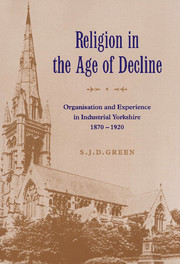Book contents
- Frontmatter
- Contents
- Acknowledgements
- List of tables
- List of abbreviations
- Introduction
- Part I Providing the means
- Part II Drawing in the people
- 4 The unfolding of the associational ideal: auxiliary organisations and ambitious societies
- 5 Learning advanced: the Sunday school movement, pedagogical innovation and the theory of juvenile religious development
- 6 Salvation extended: conversion, revivals and the unending mission to the people
- Part III The trials of the religious life
- Conclusion
- Bibliography
- Index
4 - The unfolding of the associational ideal: auxiliary organisations and ambitious societies
from Part II - Drawing in the people
Published online by Cambridge University Press: 08 October 2009
- Frontmatter
- Contents
- Acknowledgements
- List of tables
- List of abbreviations
- Introduction
- Part I Providing the means
- Part II Drawing in the people
- 4 The unfolding of the associational ideal: auxiliary organisations and ambitious societies
- 5 Learning advanced: the Sunday school movement, pedagogical innovation and the theory of juvenile religious development
- 6 Salvation extended: conversion, revivals and the unending mission to the people
- Part III The trials of the religious life
- Conclusion
- Bibliography
- Index
Summary
Introduction: the associational ideal defined and extended
So disparate a body of religious institutions, precariously financed and nebulously sustained, positively demanded a defining principle for their future prosperity. This was the associational ideal. At one level, it was a very simple ideal. It insisted that the Christian faith was sustained in and through the Christian Church. Hence it placed the highest premium upon the maximisation of the Church's membership. But it was not thereby a shallow ideal, for it did not presume that every person was immediately fit to be a member of the Church. It held only that every adult could become fit for that end. To that end, it extolled the virtuous means of common association; more specifically, of a common association through which men and women might be taught the rudiments of the faith; by which they might be induced to join societies dedicated to the faith, and finally from which they might be emboldened to spread that faith through mission, bands and tracts.
To be sure, it was not an ingenuous ideal. Denominational organisations emphasised its primacy as part of their competitive purposes. Nor did it exhaust the Christian virtues. Even the most devoted partisan still recognised the significance of private prayer. So much was, and is, obvious. Less so was the degree to which it became a way of organisational life increasingly determined, in its characteristic forms, by the urban and industrial environment in which it matured.
- Type
- Chapter
- Information
- Religion in the Age of DeclineOrganisation and Experience in Industrial Yorkshire, 1870–1920, pp. 181 - 210Publisher: Cambridge University PressPrint publication year: 1996



